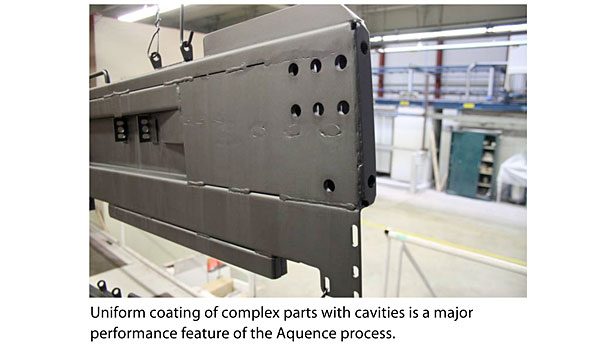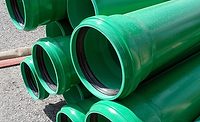Non-Electric Corrosion Protection Technology Replaces E-Coating










Perfect Performance on All Corners and Edges
“This process for coating ferrous metals is purely chemical and offers a number of decisive advantages over classic e-coating. Foremost among these is the absolutely uniform 100% coating of components or assemblies, which simply cannot be achieved with electrodeposition,” explains Claus Räckers, CEO of Räckers. Even poorly accessible areas, cavities or sharp corners and edges can be provided with a continuous layer of corrosion protection. With Aquence, there are none of the restrictions associated with the Faraday effect. “As a component manufacturer for commercial vehicles, full corrosion protection on all exterior and interior surfaces is a crucial performance feature for us and our customers,” says Räckers, explaining why the decision went in favor of the Aquence autodeposition process. At Räckers, it is used to provide long-term corrosion protection on complex tubular and pre-assembled components with intricate geometries and lengths of up to eight meters.
Chemical Instead of Electrical Action
The Aquence process also differs from classic e-coating in that it requires no metal pre-treatment and no electricity to form the coating. Through a chemical reaction in a bath of polymer emulsion, an organic layer is formed on the degreased metal surface. A mild acid releases divalent iron ions, which then combine with the paint particles in the solution and re-bond with the surface of the substrate so that each ferrous area of the component is uniformly coated in the desired thickness, while leaving plastic parts uncoated. This makes it possible not only to coat complex structures evenly inside and out, but also to process complete assemblies consisting of different materials.
The immersion coating line has now been in operation at the Räckers production site for more than a year, and its performance in terms of corrosion protection and toughness has completely convinced Räckers. “In our lab tests, the process easily achieved 1000 hours in the neutral salt spray test.” Scanning electron microscopy images show a uniform, dense wet film before curing, and consistent coating thickness even on sharp-edged geometries.
Seven Steps to Optimal Results
The robust and simple coating concept comprises just seven baths. After a four-stage cleaning and rinsing sequence, chemical deposition takes place in the Aquence bath directly on the degreased substrates. The two-stage post-rinse removes any chemical residues from the parts. “Compared to the e-coat process, the investment costs are about 20 percent lower. At the same time, the line has a smaller shopfloor footprint, partly because the usual phosphating or chromating steps are not required, and also because the oven size can be much smaller than for e-coating,” says Eric Ardourel, Technology Manager Europe at Henkel. The environmentally responsible process is therefore free of any toxic heavy metals such as zinc or nickel, and also generates practically no VOCs or hazardous sludge, all of which significantly reduces waste generation and disposal costs.
Co-Cure Process
Another positive effect on the overall process cost is the fact that it consumes less energy. Besides needing no electricity to produce the reaction in the coating bath, energy savings are also achieved due to the lower bake temperature in the subsequent two-zone ovens. “Unlike e-coating, which needs a cure temperature of about 190 °Cdue to the high VOC content, the coated components are first dried at just 60 °C, then briefly pre-baked at 140 °C. This naturally also shortens the time it takes the parts to cool down before the topcoat is applied,” says Ardourel, pointing out another special feature of the Aquence process.
About 95% of all parts at Räckers are powder coated. Crosslinking of the Aquence primer and the powder coating is performed in the same oven, also at a reduced temperature of some 170 °C. “In addition to improved energy efficiency, our tests have shown that thanks to the co-cure process, the inter-coat adhesion is enhanced, thus improving mechanical performance,” says Ardourel, explaining the advantages of being able to cure both coatings in one step. Furthermore, superior performance is achieved when bonding with structural adhesives as well.
Sustainable and Economical Coating Strategy
Technical progress and further development are also a firm feature in the corporate strategy of the BBL Oberflächentechnik group. The company, located in Roth south of Nürnberg, Germany, specializes in job coating and surface treatment for various clients. Aside from various blasting operations, such as shotblasting, carbon dioxide blasting and sandblasting, their product portfolio comprises a wide variety of coating solutions for part weights up to 20 tons. The first Aquence co-cure line in Germany went into operation here in 2007.
To complement their existing production lines, the company was looking at that time for a high-quality, environmentally benign corrosion-protection method with zero hazardous heavy metals that would also overcome the shortcomings of e-coating, primarily regarding its limited cavity coating capability. Today, steel parts weighing as much as 500 kg are coated at BBL using Aquence. Besides delivering better results, Aquence impressed this user with its sustainability and performance.
“Thanks to continuous bath maintenance, the system produces no wastewater at all,” reports CEO Robert Lumpi. The dip tank can accommodate parts with a size of up to 3,000 x 1,600 x 800 millimeters. Moreover, the low VOC content eliminates the need for post-combusting emissions, and the fact that complete assemblies can be coated provides logistical benefits by reducing the number of transports and simplifying warehousing. A high degree of automated chemical dosage reduces the need for manual maintenance and control. The compact, yet very flexible line design allows the use of Aquence as a co-cure primer in combination with various powder coatings and as a highly resistant stand-alone single-layer coating with outstanding mechanical properties. “For us, Aquence is therefore a clear winner in terms of environmental protection as well.”
Henkel Corporation received a 2010 Automotive News PACE Award for its new Aquence co-cure coating process. This prestigious U.S. award recognizes automotive suppliers for superior innovation, technological advancement and business performance.
Looking for a reprint of this article?
From high-res PDFs to custom plaques, order your copy today!








